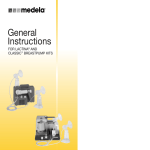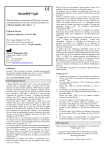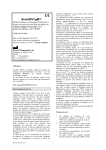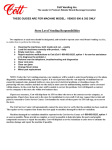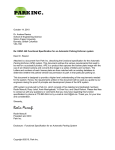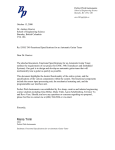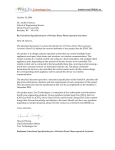Download Functional Specifications for an Infant Monitoring System
Transcript
ZenTech Canada Simon Fraser University Burnaby, BC V5A 1S6 [email protected] February 16, 1999 Dr. Andrew Rawicz School of Engineering Science Simon Fraser University Burnaby, BC V5A 1S6 Re: ENSC 370 Functional Specifications for an Infant Monitoring System Dear Dr. Rawicz: The attached document, Functional Specifications for an Infant Monitoring System, describes the complete functionality of the monitoring system we are developing. The monitoring system is intended to act as an aid in preventing Sudden Infant Death Syndrome (SIDS), which is a devastating condition that claims the lives of hundreds of Canadian children each year. This document outlines the performance criteria of the system; we discuss the operating parameters for the signal acquisition, signal conditioning, signal processing, and alarm units. Additionally, this document details the operational, physical, environmental, and safety specifications of the system. This system shall be affordable, and shall not require wires, probes or electrodes that attach to the infant. Scott D. Kulchycki, Rob Trost, Tim Wilder, Mike Sjoerdsma, and A. A. Rhiannon Coppin are the creative and motivated ZenTech engineers. Please feel free to contact any of us via e-mail at [email protected]. Sincerely, A. A. Rhiannon Coppin ZenTech Canada Enclosure: Proposal for the Development of an Infant Monitoring System http://www.sfu.ca/~rtrost/zentech Functional Specifications for an Infant Monitoring System Submitted by: Rhiannon Coppin Scott Kulchycki Mike Sjoerdsma Robert Trost Tim Wilder Contact Information: Rhiannon Coppin email: [email protected] Submitted to: Andrew Rawicz School of Engineering Science Simon Fraser University Steve Whitmore School of Engineering Science Simon Fraser University Submission Date: February 18, 1999 FUNCTIONAL SPECIFICATIONS PROJECT PROPOSAL Executive Summary Sudden Infant Death Syndrome (SIDS) quietly claims the lives of 400 infants in Canada each year.1 Although advances have been made in identifying high-risk factors, children continue to die. With parents who have had infants die of SIDS, and new parents who worry about SIDS, the question of prevention inevitability arises. If there was a way of monitoring the infant to prevent SIDS, parents worldwide would surely utilize the system. More and more home monitoring systems are being developed, but they are still expensive and complex. In addition, many of these systems require multiple connections to the infant. ZenTech Canada is committed to creating the Infant Monitoring System (IMS), which will be an affordable, reliable, and non-intrusive monitoring solution. It is our sincere hope that this device will help save the lives of children around the world. ZenTech’s IMS will use vibrations from the sleeping infant’s respiratory activity to monitor the state of the child. The IMS system will acquire this signal from the infant without any direct attachments to the child’s body. The system will then perform conditioning and processing functions on the vibration signal to determine whether the infant is still breathing. A user interface will inform the parent or caretaker of the current status of the baby’s breathing. This document introduces and discusses the main functional blocks comprising the IMS in addition to the operational, physical, environmental, and safety performance specifications of the system. A section describing the physiological factors associated with a SIDS death is included. © 1999 ZENTECH I FUNCTIONAL SPECIFICATIONS PROJECT PROPOSAL Table of Contents Executive Summary ....................................................................i List of Figures ............................................................................iv List of Tables ..............................................................................v Introduction.................................................................................1 Background ................................................................................2 System Overview........................................................................3 Signal Acquisition .......................................................................5 Signal Conditioning.....................................................................6 Signal Processing and Analysis .................................................7 User Interface .............................................................................9 System Safety Requirements...................................................10 Crib Attachments ...............................................................10 Mattress Attachments ........................................................10 Blanket Attachments..........................................................11 Base Station.......................................................................11 System Reliability...............................................................11 System Physical Requirements................................................13 User Training .....................................................................13 System Environmental and Electrical Requirements ...............14 © 1999 ZENTECH II FUNCTIONAL SPECIFICATIONS PROJECT PROPOSAL System Evaluation and Probable Limitations...........................15 System Evaluation .............................................................15 Possible System Limitations ..............................................15 Conclusion................................................................................16 References ...............................................................................17 © 1999 ZENTECH III FUNCTIONAL SPECIFICATIONS PROJECT PROPOSAL List of Figures Figure 1 – System Context Diagram...........................................3 Figure 2 – System Block Diagram ..............................................3 Figure 3 – System Context Diagram (Signal Acquisition) ...........5 Figure 4 – Signal Acquisition Flowchart......................................5 Figure 5 – System Context Diagram (Signal Conditioning).........6 Figure 6 - Signal Conditioning Flowchart ....................................6 Figure 7 – System Context Diagram (Signal Processing)...........7 Figure 8 – IMS Signal Processing Flowchart..............................8 Figure 9 – System Context Diagram (User Interface).................9 © 1999 ZENTECH IV FUNCTIONAL SPECIFICATIONS PROJECT PROPOSAL List of Tables Table 1 – IMS Physical Requirements......................................13 Table 2 - IMS Durability Requirements .....................................13 Table 3 - IMS Environmental Requirements.............................14 Table 4 - IMS Electrical Requirements......................................14 © 1999 ZENTECH V FUNCTIONAL SPECIFICATIONS PROJECT PROPOSAL Introduction It is not uncommon for parents, worried for their infant's health, to stay awake and watch their child sleep or to check on the infant’s breathing several times during the night. Some parents of children with an identifiable risk for dying from Sudden Infant Death Syndrome (SIDS) rightfully opt to purchase or rent expensive, complex, and often highly invasive monitoring equipment in the hopes of preventing a SIDS death. However, due to the high cost and complexity of available systems, this is not an option for all parents. ZenTech will create the Infant Monitoring System (IMS). The IMS will be a system whose interface to the sleeping child is virtually invisible, requiring no direct contacts to the infant. A user interface will provide the parent of caretaker with information concerning the current status of the infant’s breathing. The IMS will be reliable and inexpensive such that it will be accessible by almost all parents. The IMS will prove to be an invaluable addition to the class of currently available home monitors. The purpose of this document is to describe the physical, environmental, and safety requirements for the system in addition to discussing the various functional operations which the system will perform. This document has been prepared by the design engineers of ZenTech Canada for internal reference and for external distribution to Andrew Rawicz, Steve Whitmore, Greg Hall, Jason Rothe, Victor Ting, and other external design consultants. © 1999 ZENTECH 1 FUNCTIONAL SPECIFICATIONS PROJECT PROPOSAL Background Despite the intense research and investigation directed towards SIDS, there is still no clear reason as to why it occurs or what circumstances precede the SIDS death of a child. Current research seems to indicate that there may be many causes of SIDS. Poor prenatal care for the baby such as smoking and taking drugs during the pregnancy appears to increase the occurrence of SIDS. Overheating of the infant while sleeping or second hand smoke in the nursery may trigger SIDS.1, 2 There are many other environmental factors currently being investigated for their links to SIDS deaths. At the present time, there is one factor many researchers feel to be the most likely cause of SIDS: the cessation of breathing in the infant.3 Cessation may be due to sleep apnea or internal blockage of the mouth, nose, or windpipe by a foreign object. The stoppage of breathing may also occur when the infant’s mouth or nose becomes pressed into a blanket or mattress and the child cannot move into a clear breathing position. This situation may result in the build up of fatal concentrations of CO2, eventually suffocating the child.4 The cessation of breathing may first appear as a slowing or an abrupt stoppage of the child’s breath. Because current research seems to support cessation of breathing as a main cause of SIDS, the ZenTech IMS will monitor the breathing of the infant. This monitoring will be performed based on the vibrations emitted by the sleeping and breathing infant. © 1999 ZENTECH 2 FUNCTIONAL SPECIFICATIONS PROJECT PROPOSAL System Overview The Infant Monitoring System (IMS) will use vibrations that the infant produces while sleeping as input. Figure 1 shows the system block diagram. The diagram indicates that the input for the system is from a sleeping infant and the output will provide information to the parent or caretaker of the child. Note that all of the sensing of the infant will be accomplished without the use of any electrodes or other devices that need to be attached to the baby. Infant Monitoring System Alarm System User Input Figure 1 – System Block Diagram The IMS will gather a signal from the infant via the input sensors. This signal will then be conditioned and processed in such as manner as to allow analysis of the signal to determine the status of the infant’s breathing. This information will be relayed by the IMS user interface. Figure 2 displays the IMS system context diagram. The details of each of the major blocks are discussed in later sections. Signal Acquisition Signal Conditioning Signal Processing Figure 2 – System Context Diagram © 1999 ZENTECH 3 User Interface FUNCTIONAL SPECIFICATIONS PROJECT PROPOSAL The IMS will be designed such that the system provides the following functionality: • • • • • • • • • • • • • Utilize vibrations as the standard signal input Have a clearly marked power switch Have a response time of maximum 30 seconds to an emergency situation Require no attachments to the infant for signal acquisition Provide feedback on the status of the child which will be intuitively obvious to understand Notify the user audibly when an undesired breathing characteristic is detected Notify the user when a power failure has occurred so that they know that the infant is no longer being monitored Be economically affordable for most families Be aesthetically pleasing and require minimal space Be easily sanitized Be reliable, generating no false alarms Comply with all infant bedding safety standards and regulations Be Y2K compliant © 1999 ZENTECH 4 FUNCTIONAL SPECIFICATIONS PROJECT PROPOSAL Signal Acquisition The first task of the monitor is to acquire a signal that will be able to give a clear indication as to the status of the subject being monitored. This consists of both physically registering a signal and converting it to an electrical waveform. Figure 3 displays the context diagram for signal acquisition. Signal Acquisition Signal Conditioning Signal Processing User Interface Figure 3 – System Context Diagram (Signal Acquisition) The infant's breathing signal will be acquired by an array of sensors that will convert the signals into the electrical domain as shown in Figure 4. Electric Signal Mechanical signal (vibration) Sensor Array Figure 4 – Signal Acquisition Flowchart The sensors used to acquire the signal will: • • • • • • • Acquire vibrations and convert them to an electrical signal Be extremely sensitive Output a signal with a high signal to noise ratio Be insensitive to electromagnetic interference Be contained in a water-resistant package Not attach directly to the subject Meet all infant safety requirements © 1999 ZENTECH 5 FUNCTIONAL SPECIFICATIONS PROJECT PROPOSAL Signal Conditioning The second stage of the IMS system is to filter out background noise, transmission noise, and capacitive effects from the acquired signal. In addition, it is necessary to amplify this signal and improve its signal to noise ratio. Figure 5 shows the context diagram of this stage. Signal Acquisition Signal Conditioning Signal Processing User Interface Figure 5 – System Context Diagram (Signal Conditioning) The flowchart representing the operation of the signal conditioning stage is illustrated in Figure 6. The input signal from the signal acquisition stage is amplified and filtered before being transmitted to the signal processing and analysis stage. Input Signal Output Signal Amplifier Filter Figure 6 - Signal Conditioning Flowchart The signal conditioning stage of the IMS will provide the following functionality: • Receive an input signal from the previous signal acquisition stage • Filter out unwanted noise and information from the input signal (increase the signal to noise ratio) • Amplify the input signal • Provide an output signal that is available to the signal processing and analysis stage © 1999 ZENTECH 6 FUNCTIONAL SPECIFICATIONS PROJECT PROPOSAL Signal Processing and Analysis The signal processing stage will use the conditioned signal generated by the preceding stage and convert it to a digital signal such that the signal can be processed and subsequently analyzed to determine the status of the infant's breathing. The signal processing and analysis stage will also determine whether the system still has main power. Figure 7 shows the context diagram highlighting the Signal Processing stage. Signal Acquisition Signal Conditioning Signal Processing User Interface Figure 7 – System Context Diagram (Signal Processing) The signal input from the signal conditioning stage is first converted from analog into digital. Signal analysis is then performed on this signal to determine the status of the baby’s breathing. This information is then relayed to the IMS user interface. The signal input for the power supply is analyzed to determine whether there is still power to the system. This information is also transmitted to the user interface. The flowchart for the signal processing and analysis stage is shown in Figure 8. © 1999 ZENTECH 7 FUNCTIONAL SPECIFICATIONS PROJECT PROPOSAL Input from signal conditioning block Input from power supply Analog/Digital Converter Signal Calculations Verify Power Signal Verify Baby Status Output Data to User Interface Figure 8 – IMS Signal Processing Flowchart The signal processing stage will: • Convert the input signal from the signal conditioning stage into a digital format • Perform calculations and operations on the digital signal to determine the status of the infant’s breathing • Accept a signal from the system power supply • Perform calculations on the power supply signal to determine whether the system is still powered • Provide output to the user interface reflecting the current status of the child and system power supply © 1999 ZENTECH 8 FUNCTIONAL SPECIFICATIONS PROJECT PROPOSAL User Interface Once properly installed, all system control and feedback will be through a user interface. Figure shows the context diagram highlighting the User Interface stage. Signal Acquisition Signal Conditioning Signal Processing User Interface Figure 9 – System Context Diagram (User Interface) The user interface will: • • • • • Be mountable on the outside of the crib and meet with all safety specifications Contain an LCD display providing infant and system status information Contain a power switch Contain buttons for the purpose of silencing the alarm, and other functions Contain an audible alarm to notify the caregivers that the system can no longer detect breathing • Be connected to the main processing unit using a cable • Have a battery back-up which will sound the alarm in the event of a power failure • Meet all infant safety requirements © 1999 ZENTECH 9 FUNCTIONAL SPECIFICATIONS PROJECT PROPOSAL System Safety Requirements As the ZenTech Infant Monitoring System will be integrated with an infant’s crib and will be located within the nursery, the product will meet the following safety requirements. These requirements are in accordance with the Canadian Safety Association, the Consumer Product Safety Commission, the SIDS Network, SIDS Canada, the United States Food and Drug Administration, and the Canadian Health Department in addition to parental concerns.5, 6, 7, 8, 9, 10, 11 Crib Attachments Crib attachments are defined as any system components which will be affixed to the sides of the infant’s crib. Such components will adhere to the following safety restrictions: • The component(s) will have no sharp edges or corners exposed • The component(s) will have no protrusions with a height of greater than 3mm; the component(s) will have no protrusions on which the infant’s clothes could catch • The component(s) will have no openings such that the infant’s head or limbs could become caught • The component(s) will have no spacings of width less than 6mm in which the infant’s body could become caught • The component(s) will have no wires or cords in which the infant could become entangled • The component(s) will be electrically isolated such that there is no risk of electrical shock • The component(s) will produce minimal heat and negligible sound • The component(s) will not be subject to electromagnetic interference • The component(s) will be non-allergenic and fire-retardant Mattress Attachments Mattress attachments are defined as any system components which will be affixed to or placed over top of the crib mattress. Such components will adhere to the following safety restrictions: • The component(s) will be firm or will not lessen the firmness of the infant’s mattress • The component(s) will not cause gaps to occur between the sleeping surface of the crib and the frame of the crib which exceed 3mm • The component(s) will have no sharp edges or corners • The component(s) will have no protrusions of a height greater than 3mm; the component(s) will have no protrusions on which the infant’s clothing could catch • The component(s) will be waterproof, fire-retardant, and non-allergenic • The component(s) will have no wires or cords in which the infant could become entangled • The component(s) will be electrically isolated such that there is no risk of electrical shock © 1999 ZENTECH 10 FUNCTIONAL SPECIFICATIONS PROJECT PROPOSAL • • • • The component(s) will not generate heat or sound The component(s) will not be subject to electromagnetic interference The component(s) will remain stationary; the component(s) will not “bunch up” The component(s) will not generate lint Blanket Attachments Blanket attachments are defined as any system components which will be affixed to or incorporated within the infant’s sleeping blanket. Such components will adhere to the following safety restrictions: • The component(s) will have no sharp edges or corners • The component(s) will have no protrusions of a height greater than 3mm; the component(s) will have no protrusions on which the infant’s clothing could catch • The component(s) will be waterproof, fire-retardant, and non-allergenic • The component(s) will have a weight no greater than 250g • The component(s) will have no wires or cords in which the infant could become entangled • The component(s) will be electrically isolated such that there is no risk of electrical shock • The component(s) will not generate heat or sound • The component(s) will not be subject to electromagnetic interference • The component(s) will not generate lint Base Station The system base station is defined as the unit which will be separate from the signal acquisition components (located in or on the crib) where signal conditioning, signal processing, and user interface functions occur. The system base station will adhere to the following safety restrictions: • The base station will have no sharp edges or corners • The base station will be electrically isolated such that there is no risk of electrical shock • The base station will be fire-retardant and non-allergenic • The base station will generate minimal heat • The base station will not be subject to electromagnetic interference The ZenTech IMS will adhere to all CSA, UL, and CE consumer product standards. System Reliability Because the IMS is being used to monitor infants, it must have a very high accuracy rate. The tolerance for not determining that a breathing problem has occurred when, in fact, it has (false positive error) will be as close to zero as possible. The tolerance for detecting a problem when there is none (false negative error) is not as critical as false positive errors and thus will be allowed to two percent. To summarize: © 1999 ZENTECH 11 FUNCTIONAL SPECIFICATIONS PROJECT PROPOSAL Accuracy in detecting a breathing failure (false negative error): 99% Accuracy in falsely detecting a non-existent breathing failure (false positive error): 98% © 1999 ZENTECH 12 FUNCTIONAL SPECIFICATIONS PROJECT PROPOSAL System Physical Requirements The ZenTech Infant Monitoring System will adhere to the physical requirements outlined in Table 1. Table 1 – IMS Physical Requirements Crib Attachment Mattress Attachment Blanket Attachment Base Station Length Width Depth Weight Length Width Height Weight Length Width Depth Weight Length Width Height Weight Less than 20cm Less than 20cm Less than 10cm Less than 500g No less than 3mm shorter than the crib mattress length No less than 3mm shorter than the crib mattress width Less than 2.5cm Less than 1kg Less than 20cm Less than 20cm Less than 2.5cm Less than 250g Less than 25cm Less than 20cm Less than 15cm Less than 1kg The ZenTech Infant Monitoring System will adhere to the durability requirements outlined in Table 2. Table 2 - IMS Durability Requirements Mattress Attachment Blanket Attachment Base Station Strength Structure Strength Structure Strength Structure Withstand forces of baby movement Waterproof and washable with a damp cloth Withstand forces of baby movement Waterproof and washable with a damp cloth Withstand a drop from up to 2 meters Washable with a damp cloth User Training The IMS will be accompanied by a short user manual which will describe how the system should be installed to the infant’s crib. A short description of what to do in the case of an emergency will also be included in the manual. The manual will also discuss other SIDS prevention methods. © 1999 ZENTECH 13 FUNCTIONAL SPECIFICATIONS PROJECT PROPOSAL System Environmental and Electrical Requirements The ZenTech Infant Monitoring System will operate in an environment as outlined in Table 3. Table 3 - IMS Environmental Requirements Operating Temperature Storage Temperature Humidity Elevation +10°C to +40°C -40°C to +60°C Will work over standard humidity ranges Will work over standard elevation ranges In addition, the IMS will have the electrical characteristics outlined in Table 4. Table 4 - IMS Electrical Requirements Power Supply Max Power Dissipation © 1999 ZENTECH AC 25V 60Hz 5W 14 FUNCTIONAL SPECIFICATIONS PROJECT PROPOSAL System Evaluation and Probable Limitations System Evaluation System testing is a serious issue for a product that requires infants to be properly tested. Simply finding babies to test the system presents numerous technical and ethical issues. The system will first be fully tested on full-grown adults, then tested with a limited number of sleeping babies with the permission of their parents. Unfortunately, it is essentially impossible and ethically unsound to reenact the exact situation that occurs during a SIDS death. Thus, the system will be tested only with living babies, under the assumption that removing the infant from the monitor will emulate a cessation of breathing. Possible System Limitations The following may compromise the functionality of the IMS: • The IMS assumes that the accepted SIDS standard of positioning of the infant in the crib will be used; this position requires that the infant be placed on his back with his feet touching the foot of the crib.12 Failure to properly position the child may reduce the effectiveness of the monitor. • The IMS will not function when there is a power failure © 1999 ZENTECH 15 FUNCTIONAL SPECIFICATIONS PROJECT PROPOSAL Conclusion This document discussed the functional specifications and safety, environmental, and physical requirements to be used as a basis for ZenTech’s Infant Monitoring System (IMS). These functional specifications addressed the functional issues associated with building an infant monitoring system. ZenTech will adhere to these specifications when building the IMS, in hopes of developing a reliable monitoring system. The ZenTech team is dedicated to developing a monitor that will be simple to use, effective, and accessible by almost all parents. Only then will we have truly contributed to the fight against SIDS. © 1999 ZENTECH 16 FUNCTIONAL SPECIFICATIONS PROJECT PROPOSAL References 1. “Reducing the Risk of Sudden Infant Death Syndrome in Canada”, http://hwcweb.hwc.ca/hpb/lcdc/brch/reprod/sidsjo.html, January 1999. 2. “Smoking and the Risk of SIDS”, http://sids-network.org/smok.htm, January 1999. 3. Carroll, John L., MD. “SIDS suffocation, asphyxia, and sleeping position”, http://www.sids-network.org/carroll2.htm, January, 1999. 4. “Sudden Infant Death With External Airways Covered”, http://www.ama-assn.org/scipubs/journals/most/recent/issues/ajdc/poa7470.htm, January 1999. 5. Consumer Standards Association, http://www.csa-international.org, January 1999. 6. Consumer Product Safety Commission, http://www.cpsc.gov, January 1999. 7. SIDS Network, http://www.sids-network.org, January 1999. 8. SIDS Canada, http://www.sidscanada.org, January 1999. 9. United States Food and Drug Administration, http://vm.cfsan.fda.gov, January 1999. 10. Canada Health Department, http://hc-sc.gc.ca, January 1999. 11. Delisle, Jackee. Interview, February 5, 1999. 12. "Questions and Answers About COT Death", http://dspace.dial.pipex.com/fsid/question.htm#one, January 1999. © 1999 ZENTECH 17





























